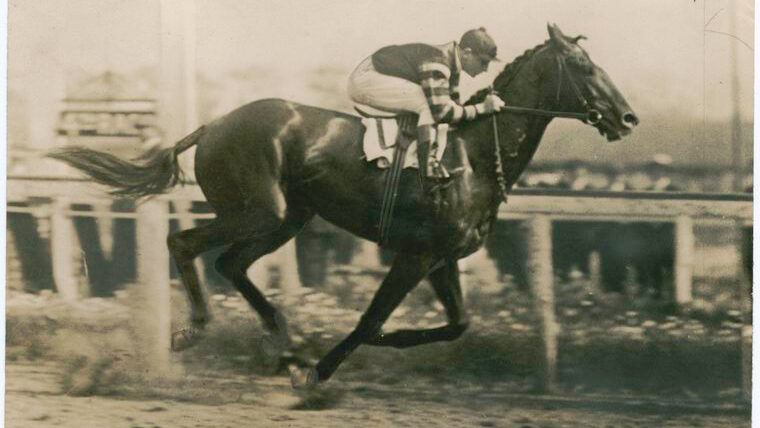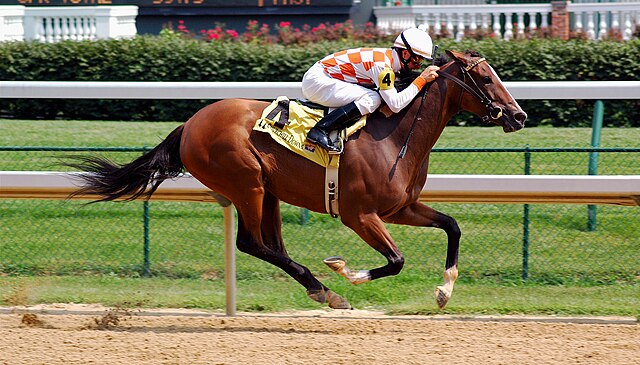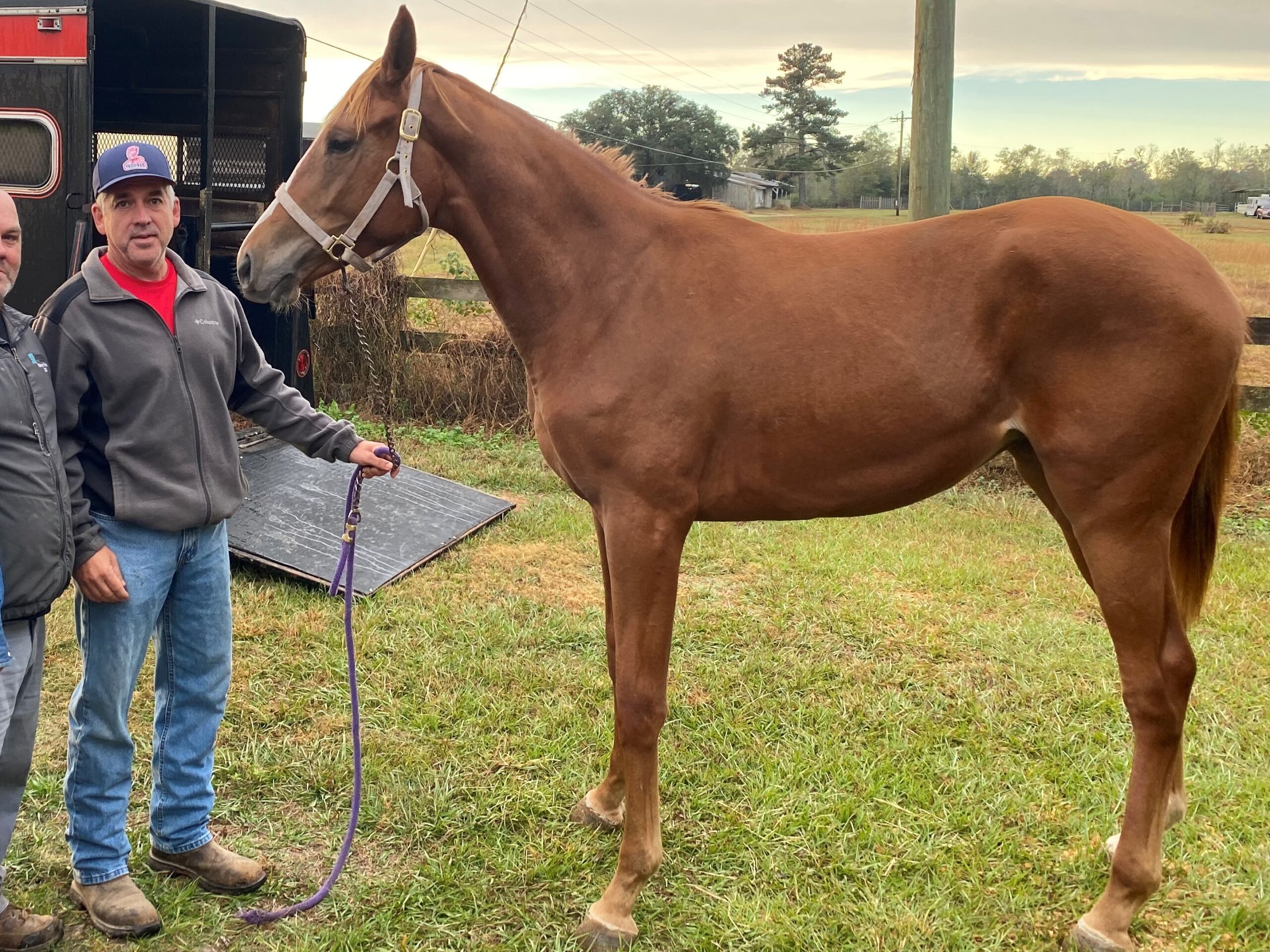Last updated: May 14, 2025
Who are the fastest racehorses in history? These remarkable athletes combine power, precision, and grace to captivate audiences on flat tracks worldwide. With over 25 years of experience owning and training racehorses in Louisiana, I’ve developed a deep appreciation for Thoroughbred legends like Secretariat, Man o’ War, and Black Caviar, alongside Quarter Horse stars like Captain BD. Thoroughbreds hold the fastest recorded speeds (~40–44 mph, e.g., Winning Brew’s 43.97 mph), while Quarter Horses dominate short sprints (~42–45 mph, e.g., Captain BD). From Black Caviar’s blazing ~37.0 mph in the 2012 Lightning Stakes to Captain BD’s 42.88 mph sprint at Hialeah Park in 2016 and Thoroughbred Winning Brew’s record-setting 43.97 mph, these horses redefine speed.
Learn what drives these champions in our guide to how fast horses run. This article explores their records, genetics, training, and traits, backed by my experience and sources like Racing Australia, AQHA, Guinness, and Science Magazine.

Fastest Racehorses in History: Profiles and Achievements
Comparing the fastest racehorses in history is complex due to varying track surfaces, weather conditions, and training advancements. Each legend shines in their era through speed, endurance, or record-breaking feats, shaped by genetics, training, and conditions like firm dirt or wind, per equine sports medicine. Explore our racetrack surface guide.
Captain BD: Quarter Horse Sprint King
- Record: Set the 220-yard world record (11.448s, 42.88 mph) in 2016 at Hialeah Park, Florida, on a fast track with no wind, per AQHA.
- How He Achieved It:
- Genetics: Captain BD’s high fast-twitch muscle fiber ratio (~70%) enabled explosive sprints, typical of Quarter Horses, per AQHA studies.
- Training: Short, high-intensity sprints honed his acceleration, with recovery periods to maintain muscle health.
- Conditions: The fast dirt track and calm weather maximized his speed; headwinds could have cut ~0.5 mph, per equine sports medicine.
- Personal Insight: Captain BD’s sprint training mirrors my approach with Quarter Horses in Louisiana, emphasizing burst speed on firm tracks.
Flightline: Modern Thoroughbred Star
- Record: Won the 2022 Breeders’ Cup Classic (1:59.11, 1.25 miles, ~37.83 mph avg) on firm dirt under clear skies, going 6–0, per Equibase.
- How He Achieved It:
- Genetics: Flightline’s balanced muscle composition and stamina, likely tied to the MSTN gene, supported long-distance speed, per Equinome studies.
- Training: Trainer John Sadler used targeted gallops and rest to peak his performance for major races.
- Conditions: Firm dirt and no wind aided his speed; high humidity could have reduced stamina slightly.
- Personal Insight: Flightline’s rest-focused training aligns with my methods to keep Thoroughbreds fresh for big races.
Secretariat: The Triple Crown Legend
- Record: Secretariat’s 1973 Triple Crown set records: Kentucky Derby (1:59.4), Preakness Stakes (1:53), and Belmont Stakes (2:24, ~37.5 mph avg, 1.5 miles) on firm dirt with no wind, winning Belmont by 31 lengths, per Kentucky Derby.
- How He Achieved It:
- Genetics: His 22-pound heart (nearly triple average) and X-Factor gene from dam Somethingroyal boosted oxygen delivery, per BloodHorse.
- Training: Trainer Lucien Laurin paired stride-efficient gallops with recovery, optimizing stamina. Tailwinds (+0.5 mph) could have pushed his peak higher.
- Conditions: Firm dirt and calm weather maximized his Belmont performance; heat/humidity could have slowed him slightly.
- Personal Insight: Secretariat’s heart size and training made him a long-distance marvel. Read more in Was Secretariat the Fastest Horse to Race?.

Winning Brew: Record-Breaking Speed
- Record: Holds the Guinness World Record for fastest speed (43.97 mph, 2 furlongs, 20.57s) at Penn National, 2008, on firm dirt with no wind.
- How She Achieved It:
- Genetics: Her Thoroughbred lineage featured ~70% fast-twitch muscle fibers, enabling explosive sprints, per Equibase.
- Training: Trainer Francis Vitale used high-intensity interval training to develop sprint speed while prioritizing muscle recovery.
- Conditions: Firm dirt and calm weather optimized her record; headwinds could have cut ~0.5 mph.
- Personal Insight: Winning Brew’s interval training maximized her sprint potential. Test similar speeds with our horse speed calculator.
Man o’ War: The Mighty Champion
- Record: Won 20 of 21 races, including the Belmont (2:14.2, 1.375 miles, ~37.5 mph avg) in 1920 on fast dirt, per Racing Museum.
- How He Achieved It:
- Genetics: His size and stride came from sire Fair Play and dam Mahubah, bred for stamina and speed.
- Challenges Overcome: Rough tracks tested his durability; firm dirt aided his Belmont win. Tailwinds (+0.5 mph) could have boosted his peak.
- Conditions: Fast dirt and pre-GPS timing limit precision, but his dominance was clear.
- Personal Insight: Training Man o’ War today would involve varied surfaces to build adaptability. Learn more in Man o’ War: The Fastest Horse to Race?.
Dr. Fager: The Versatile Speedster
- Record: Set the mile record (1:32.2, ~41.38 mph) in 1968 at Arlington Park on fast dirt with mild weather, earning Champion Sprinter, Grass Horse, and Horse of the Year, per BloodHorse.
- How He Achieved It:
- Genetics: Balanced muscle composition optimized stride efficiency across distances.
- Training: Trainer John Nerud blended sprints and gallops, with recovery to sustain peak form.
- Conditions: Fast dirt and mild weather aided his record; heat/humidity could have slowed stamina.
- Personal Insight: Dr. Fager’s versatile training inspires my approach to balancing speed and endurance. Explore his legacy in Dr. Fager: World’s Greatest Racehorse.
Black Caviar: Undefeated Sprinter
- Record: Retired undefeated with 25 wins, including 15 Group 1 victories, reaching ~37.0 mph in the 2012 Lightning Stakes (1000m, 55.22s) on firm turf with mild weather, per Racing Australia.
- How She Achieved It:
- Genetics: Her muscular build and ~70% fast-twitch fibers drove ~150 strides per minute.
- Management: Trainer Peter Moody limited races, using targeted workouts to maintain fitness. Firm turf and no wind optimized her sprints.
- Conditions: Mild weather aided her; headwinds could have cut ~0.5 mph.
- Personal Insight: Black Caviar’s managed schedule preserved her longevity, a lesson for my training programs. See her career in Black Caviar: Fast as Lightning.
These horses showcase the pinnacle of equine speed. For a deeper dive into what drives their performance, check out our guide to how fast horses run.

Other Remarkable Racehorses to Know
Incorporate previously excluded horses while keeping descriptions concise:
- Spectacular Bid: Set a 1 1/4-mile record of 2:00 flat (~37.5 mph) in the 1980 Strub Stakes, excelling in classic distances. Learn more on The Jockey Club’s Hall of Fame page.
- Mandurah: Recorded the fastest 1-mile turf time of 1:31.23 (~41.98 mph) in the 2010 Hollywood Turf Cup, per Equibase.
- Frankel: Undefeated British champion, reaching ~37.0 mph in the Queen Elizabeth II Stakes, per Racing Post.
- Eclipse: 18th-century undefeated champion (~35–37 mph, estimated), foundational to modern Thoroughbreds, per The Jockey Club.
- Seattle Slew: The only undefeated Triple Crown winner, reaching ~37.5 mph in the 1977 Belmont Stakes, per Kentucky Derby. Visit Seattle Slew: Before and Beyond the Kentucky Derby.
- All American Futurity Winner (e.g., Flash and Roll): Quarter Horse exemplar, reaching ~42–43 mph in sprints like the 2020 All American Futurity (440 yards, ~21.0s), per AQHA. Unlike unverified claims for *A Long Goodbye* (e.g., 55 mph), this record is verified.
- Kincsem: Hungarian mare with an unmatched 54–0 record (~35–37 mph), showcasing stamina and versatility, per Wikipedia.
- Kingston: 19th-century English Triple Crown winner (~35–37 mph, estimated), known for track records, per The Jockey Club.
For additional details, visit The Jockey Club: How Fast Are Racehorses? or Wikipedia’s List of Leading Thoroughbred Racehorses.
| Racehorse | Top Speed | Record/Notable Achievement | Era |
|---|---|---|---|
| Winning Brew | 43.97 mph | Guinness World Record for fastest speed over 2 furlongs (2008), Guinness. | Modern |
| Captain BD | 42.88 mph | 220-yard world record (11.448s, 2016), AQHA. | Modern |
| Dr. Fager | ~41.38 mph | Mile record (1:32.2, 1968); Horse of the Year, BloodHorse. | 1960s |
| Flightline | ~37.83 mph | 2022 Breeders’ Cup Classic (1:59.11, 1.25 miles); 6–0 record, Equibase. | Modern |
| Secretariat | ~37.5 mph | Fastest Triple Crown; Belmont Stakes in 2:24, Kentucky Derby. | 1970s |
| Man o’ War | ~37.5 mph | 20 wins in 21 races; Belmont Stakes in 2:14.2, Racing Museum. | 1920s |
| Black Caviar | ~37.0 mph | Undefeated with 25 wins, including 15 Group 1 victories, Racing Australia. | 2010s |
| Frankel | ~37.0 mph | Undefeated British champion; Queen Elizabeth II Stakes, Racing Post. | 2010s |
| Spectacular Bid | ~37.5 mph | 1 1/4-mile record (2:00 flat, 1980 Strub Stakes), Racing Museum. | 1980s |
| Hawkster | ~41.85 mph | Fastest 1:31.4 mile, 1989 Oak Tree Invitational, Equibase | 1980’s |
| Kincsem | ~35–37 mph | Most successful with 54 wins from 54 starts, Wikipedia. | 19th Century |
| Seattle Slew | ~37.5 mph | Only undefeated Triple Crown winner, Kentucky Derby. | 1970s |

What Factors Make a Racehorse Fast?
The speed of a racehorse is determined by a combination of genetic, physical, and environmental factors, fine-tuned by expert training and nutrition.
The Role of Genetics in Racehorse Speed
- Key Gene: The myostatin (MSTN) gene mutation influences muscle mass and sprinting ability, especially in breeds like Quarter Horses and Thoroughbreds. Horses with certain MSTN gene variants show up to 30% greater muscle efficiency, according to research published in Science Magazine.
- Additional Factors: Beyond MSTN, genes affecting cardiovascular efficiency (e.g., heart size) and oxygen delivery (e.g., hemoglobin production) also contribute to speed.
- Breeding Insights: Breeders have refined these traits through generations, using tools like genetic testing (e.g., Equinome Speed Gene Test) to predict a foal’s potential.
Racehorse Training and Nutrition for Optimal Speed
- Training Focus: Elite racehorses, like Secretariat, have stride lengths between 21–24 feet. Interval training—alternating between high-intensity sprints and slower gallops—is key to improving stamina and stride frequency. Stride efficiency plays a vital role in racehorse speed, as explored in the Biomechanical Sensors section.
- Personal Note: I’ve found that incorporating uphill gallops into training regimens strengthens hindquarters, improving both stride length and power.
- Want to improve your horse’s speed through proven techniques? Check out our in-depth guide on training horses for speed to discover practical methods.
- Dietary Data: A Thoroughbred consumes up to 25 pounds of feed daily, with 12–15% protein for muscle growth and fats for sustained energy. Electrolytes replenish minerals lost during intense training.
How Environment Impacts Horse Speed
Speed depends heavily on track conditions, weather, and competition:
- Track Surface: Dirt tracks favor faster times due to their firm, flat surfaces, while turf tracks can slow horses due to softer footing.
- Example: Mandurah’s 1-mile turf record of 1:31.23 highlights how specialized training for turf surfaces can yield incredible results.
- Weather Conditions: Optimal performance often occurs under clear skies and moderate temperatures, as seen during Secretariat’s 1973 Kentucky Derby win. Headwinds can slow horses by ~0.5 mph, tailwinds boost by ~0.5 mph, and high heat or humidity reduces stamina, per equine sports medicine.
- Shoeing Impact: Proper shoeing helps horses adapt to different surfaces, reducing slippage and maximizing traction.

Breed Comparisons: Speed and Physical Characteristics
Each breed excels in specific areas of racing due to their unique physical traits, muscle composition, and historical breeding.
| Breed | Top Speed | Best For | Key Traits |
|---|---|---|---|
| Thoroughbred | ~40–44 mph | Long-distance racing | Lean, long legs, high lung capacity, balance of muscle fibers |
| Quarter Horse | ~43–45 mph | Short sprints | Compact, muscular build, ~70% fast-twitch fibers |
| Arabian | ~35–40 mph | Endurance racing | Small frame, slow-twitch fibers for stamina, efficient energy use |
| Appaloosa | ~40–43 mph | Versatility (speed/endurance) | Balanced muscle fibers, sturdy build |
Sources: AQHA, Equibase, Arabian Horse Association, Appaloosa Horse Club.
- Thoroughbreds: Originating in 17th-century England, Thoroughbreds were bred for stamina and agility, excelling in races like the Kentucky Derby, with record speeds in our Comparison Table (e.g., Winning Brew). Explore more about the Thoroughbred horse breed.
- Quarter Horses: Developed in colonial America for short-distance sprints, their high percentage of fast-twitch fibers makes them explosive sprinters, with top speeds in our Comparison Table (e.g., Captain BD). Claims of 55 mph (e.g., A Long Goodbye) are unverified. Learn more about the versatile American Quarter Horse.
- Arabians: One of the oldest breeds, Arabians were bred for endurance in harsh desert conditions, relying on slow-twitch fibers to conserve energy. Find out more about the rich history of the Arabian horse breed.
- Appaloosas: Bred by the Nez Perce tribe, their balanced muscle composition makes them versatile in both speed and endurance events. Learn more about the Appaloosa horse breed.
Want to know which breeds dominate in speed? Discover the fastest horse breeds and their unique traits.

Muscle Fiber Types and Racing Performance
Connect muscle composition directly to breeds and individual examples:
- Fast-Twitch Dominance: Quarter Horses’ 70% fast-twitch fibers make them ideal for short sprints. Captain BD’s 42.88 mph (AQHA) exemplifies this trait, unlike unverified claims for A Long Goodbye.
- Balance of Speed and Endurance: Thoroughbreds, such as Secretariat, possess ~55% fast-twitch fibers, giving them the ability to sustain high speeds over longer distances. ResearchGate’s study on equine muscle fiber distribution offers more insight into how this composition influences their performance.
- Versatility: Appaloosas’ balance of fast- and slow-twitch fibers enables them to excel in events requiring a mix of speed and endurance.
What’s your favorite breed for speed and endurance? Let me know in the comments!
By understanding how these muscle fibers work, we gain valuable insights into why certain breeds excel in specific racing scenarios. To explore more about the relationship between muscle composition and performance, visit Equine Muscle Fiber Types.
Ethical Considerations in Horse Racing
The relentless pursuit of speed in horse racing brings ethical challenges that directly impact performance and longevity. Unethical practices such as overtraining or breeding for narrow traits can lead to injuries, genetic vulnerabilities, and health issues that impair a horse’s ability to achieve its maximum speed.
- Rest and Recovery: Adequate rest is critical for peak performance. For example, after a taxing race, I give my horses a six-week recovery period, ensuring they return to training refreshed and less prone to injury.
- Breeding Practices: While breeding for speed is essential, overemphasis on specific bloodlines has led to unintended consequences, such as increased risks of fractures in Thoroughbreds. The Jockey Club promotes ethical breeding practices to reduce these genetic vulnerabilities and safeguard the future of racing.
- Injuries from Overtraining: Intense training regimens can lead to stress fractures, tendon injuries, and joint damage, all of which limit a horse’s ability to perform at its peak.
At my barn, I prioritize rest and recovery to ensure the long-term health of my horses. After a taxing race, my horses get at least six weeks off before resuming training. During this time, I monitor their physical and mental well-being, incorporating light turnout sessions to keep them active without strain.
What are your thoughts on the balance between performance and welfare in horse racing? Let me know in the comments—I’d love to hear your perspective!

The Future of Horse Speed: Innovations and Challenges
Advancements in genetics, training, and nutrition are reshaping the landscape of horse racing. These innovations offer exciting opportunities to breed and train faster, stronger, and healthier racehorses while maintaining their well-being.
Genetic Testing for Faster Racehorses
Modern genetic testing tools like the Equinome Speed Gene Test are revolutionizing horse breeding by identifying key genetic markers linked to speed, stamina, and sprinting ability. One crucial marker is the myostatin (MSTN) gene, which influences muscle mass and sprinting potential.
- Real-World Impact: Breeders are actively using genetic testing to produce record-breaking sprinters, such as those optimized for distances of five to six furlongs, where explosive speed is key. This technology ensures that foals have the genetic traits needed to excel in specific racing conditions.
- Learn More: Unlock the secrets of breeding record-breaking racehorses by reading our article on Thoroughbred Genetics: Breeding for Speed.

Using Biomechanical Sensors to Optimize Stride Efficiency
Biomechanical sensors track key metrics like stride length, stride frequency, and ground impact. These insights help trainers make precise adjustments to training programs to improve speed and reduce injury risk.
- Real-World Example: A racehorse’s stride analysis revealed subtle inefficiencies. Adjustments to shoeing improved its stride efficiency, resulting in faster times.
- Elite Stride Length: Secretariat, with a stride length of 21–24 feet, exemplifies how stride optimization can boost both speed and stamina. Advanced sensors could analyze such stride mechanics in real-time, refining modern training practices.
- Training Applications: Combining data from biomechanical sensors with traditional interval training (e.g., alternating high-intensity sprints and gallops) can enhance a horse’s stride frequency and overall efficiency.
- Curious about how technology is revolutionizing equine performance? Dive into our article on Equine Speed Mechanics to learn how sensors and analytics refine training.
Nutrition Science: Boosting Endurance and Recovery
Breakthroughs in equine nutrition are helping racehorses achieve peak performance by improving endurance, reducing recovery times, and preventing fatigue. Specialized diets and supplements play a pivotal role in enhancing overall performance.
- Key Nutritional Advances:
- Amino Acids: Supplements like lysine support muscle repair and improve recovery after intense workouts.
- Omega-3 Fatty Acids: These reduce inflammation and support joint health, critical for maintaining speed and preventing injuries.
- Performance Feeds: High-fat diets provide sustained energy, ensuring horses can maintain top speeds over longer distances.
- Nutrition plays a vital role in maximizing a racehorse’s endurance and recovery. Explore our guide on feeding performance horses for actionable advice on optimizing your horse’s diet.
- Real-World Application: Research shows that horses receiving balanced amino acid and fat-rich diets recover faster and perform more consistently. For instance, omega-3 supplements have been linked to improved joint flexibility, which enhances stride length and efficiency.
- Personal Insight: Adding beet pulp and alfalfa to my horses’ diets has significantly improved their endurance and post-race recovery. These nutritional tweaks, combined with electrolyte supplements, have kept my horses at peak performance during rigorous racing seasons.
The Road Ahead: Balancing Innovation and Welfare
The future of horse racing depends on combining these advancements with ethical care. Innovations like genetic testing, biomechanical sensors, and advanced nutrition provide immense potential for creating faster racehorses. However, ensuring these technologies are used responsibly to prioritize the long-term health and well-being of these incredible athletes is vital.
- Ethical Integration: Breeding programs must focus on producing not only faster horses but also those with robust physical health to avoid genetic vulnerabilities. Similarly, training and nutrition advancements should aim to enhance performance without compromising welfare.
- Explore More: Read about the evolving future of racing in Will Horses Get Faster?.

Frequently Asked Questions About The Fastest Racehorses in History
Who was faster, Secretariat or Man o’ War?
Secretariat’s recorded times, like his 2:24 Belmont Stakes in 1973 (~37.5 mph), are unmatched. Man o’ War’s ~37.5 mph (1920 Belmont) was dominant, but pre-GPS timing limits precision, per Racing Museum.
Why is the top speed of a Quarter Horse higher than that of a Thoroughbred?
What’s the difference between peak speed and sustained speed?
Peak speed is the maximum speed in a short burst (e.g., Quarter Horses like Captain BD), while sustained speed is maintaining high speed over distance (e.g., Thoroughbreds like Secretariat).
Are genetics the main reason some horses are faster?
Yes, genes like the MSTN gene and traits like stride length play a big role, but training, nutrition, and track conditions are also crucial.
Can a racehorse be both fast and durable?
Yes, with careful management. Breeding for strong conformation and balancing speed with recovery ensures durability, as seen in horses like Seattle Slew.
What is the fastest horse breed?
Thoroughbreds hold the fastest recorded speed, with Winning Brew reaching 43.97 mph (Guinness World Record, 2008), excelling in both sprints and longer races (~40–44 mph). Quarter Horses dominate short sprints, consistently hitting ~42–45 mph (e.g., Captain BD’s 42.88 mph). See our guide to horse racing speeds.
How does weather affect racehorse speed?
Headwinds slow horses by ~0.5 mph, tailwinds boost by ~0.5 mph, and high heat or humidity reduces stamina, slightly lowering speed, per equine sports medicine.
Conclusion: Legends of Speed and the Future of Racing
The fastest racehorses in history—like Secretariat’s Triple Crown dominance and Winning Brew’s record-breaking sprint—showcase the perfect blend of genetics, training, and determination. These living legends remind us of the extraordinary potential of these majestic animals.
As advancements in genetics, training, and nutrition continue to evolve, the future of racing holds even greater possibilities. Balancing these innovations with ethical care will ensure the sport honors both the legacy of these champions and the welfare of future racehorses.
Ever wondered about the fastest times recorded in horse racing? Who is your favorite legendary racehorse? Do you think the fastest records can ever be surpassed? Share your thoughts below!
Explore our detailed breakdown of racing records and the horses who achieved them. Subscribe to our newsletter for weekly tips on training, racing insights, and horse care.

About the Author: Miles Henry
Lifelong Horseman | Racehorse Owner | Published Author
Miles Henry brings over 25 years of hands-on experience training and owning Thoroughbred racehorses. Raised with Quarter Horses and Appaloosas, he’s spent a lifetime learning from horses—on the track, in the barn, and in the field. Today, he runs a small but successful racing stable in Louisiana and shares real-world insights on HorseRacingSense.com, helping horse owners, fans, and bettors navigate the sport with confidence.
📚 Books: View Miles’s books on Amazon »
🎧 Podcast Guest: Animal Tales Ep. 32 |
YouTube Interview
📩 Newsletter: Sign up for racing tips and horse care advice »
🔗 Follow Miles:
Twitter |
Facebook |
YouTube

